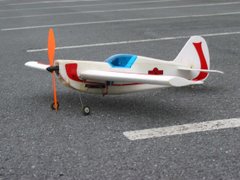"Everyone crashes. If you don't then you're not flying."
I have gotten too comfortable . . . I was in the process of landing after a ten minute flight using throttle maintenance, so I should have had plenty of power for landing. I was flying to an adjacent baseball diamond, a last minute decision, because of the wind direction and I had to cross the sun. I juiced the throttle to fly above the sun from my point-of-view to avoid being blinded . . . suddenly my plane dove -- I was 12 to 18 feet from the ground. I panicked. I over sticked and my plane spiraled. I could not tell if I was upside up or upside down.
To this day I wonder if my batt was to low and ESC cut power momentarily. That's the only way I can explain the dive.
The obvious solution would have been to land in the grass next to me so I could see my plane and guide it to the ground safely.
 Above is what my plane looked like after the hard nose dive and somersaulted across the grass field at a local park. As you can see this is a critical spot that endures a lot of stress, because it houses my motor mount. The prop didn't fair to well either.
Above is what my plane looked like after the hard nose dive and somersaulted across the grass field at a local park. As you can see this is a critical spot that endures a lot of stress, because it houses my motor mount. The prop didn't fair to well either. Typically the longer it takes for an epoxy to cure the heavier the epoxy weighs. It is best to use as little epoxy as possible, but in case like this I was generous. You should wipe off all excess glue immediately. Ninety-five percent of the time CA glue or 5-minute Epoxy is the best choice for park flyers, but this time I used 24-hour epoxy because I need this bond to be very strong. This slower epoxy also allows me to set everything perfectly and check and then recheck.
Typically the longer it takes for an epoxy to cure the heavier the epoxy weighs. It is best to use as little epoxy as possible, but in case like this I was generous. You should wipe off all excess glue immediately. Ninety-five percent of the time CA glue or 5-minute Epoxy is the best choice for park flyers, but this time I used 24-hour epoxy because I need this bond to be very strong. This slower epoxy also allows me to set everything perfectly and check and then recheck. The best way to tighten up the sides in a glue job like this is criss-cross your needles at opposing angles. This will not only pull the sides closer together, but also hold them better. I should have done that more on this job, but if you look at the top end you will see that I did.
The best way to tighten up the sides in a glue job like this is criss-cross your needles at opposing angles. This will not only pull the sides closer together, but also hold them better. I should have done that more on this job, but if you look at the top end you will see that I did.I aim to fly again as soon as the weather permits.

3 comments:
Nice repair job. A lot better looking than some of my old work on Maxine.
Not as clean as I'd like. But it worked.
Where did you hear that slower epoxy is heavier? Data sheets I've seen disagree. 24-hour stuff (West System, Raka, etc) is certainly stronger, but if it was heavier, why would homebuilt aircraft (the kind you sit in) or competition model sailplanes use it?
Post a Comment